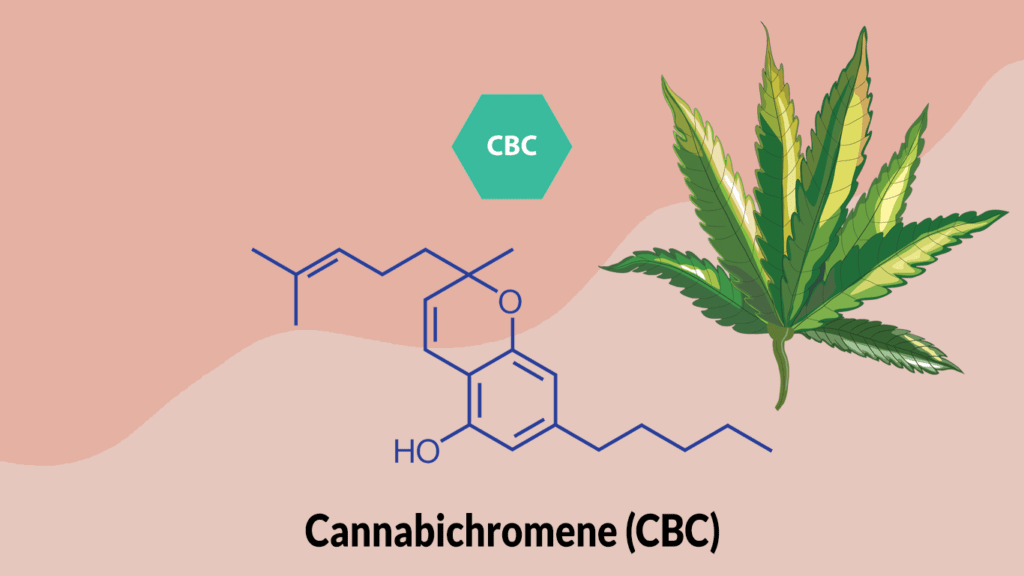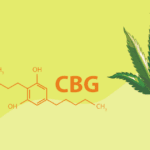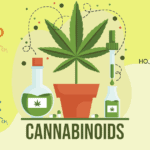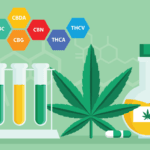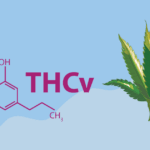Cannabichromene (CBC) is a minor cannabinoid found in cannabis plants. It’s derived from cannabichromenic acid (CBCa), which itself comes from a precursor known as cannabigerolic acid (CBGa).
CBC appears to have similar effects as CBD, including pain relief, mood support, and anti-inflammatory properties, but may also have some unique properties. Here’s everything you need to know about cannabichromene, including its effects, safety, and where to find it.
Table of Contents
CBC vs. CBD
| CBC | CBD | |
| Intoxicating? | No | No |
| Main potential Benefits | Anti-inflammatory, pain relief, neuroprotective, antidepressant | Anti-inflammatory, pain relief, neuroprotective, anti-seizure, anti-anxiety, anti-nausea, anticancer, antipsychotic |
| How it works | Reducing uptake of endocannabinoids, TRP channels | FAAH enzyme, serotonin receptor, TRP channels, and more |
Potential Effects & Benefits of CBC
Few studies have tested the use of CBC in humans. However, numerous studies on animals have found evidence that CBC may have a variety of therapeutic effects.
Pain-Relieving and Anti-Inflammatory Effects
Several studies have found that CBC may reduce pain and inflammation. In 2011, a study on mice found that CBC blocks pain by affecting receptors involved with sensing pain and injury (1).
Meanwhile, a 2012 mouse study found that CBC reduced inflammatory symptoms in the intestines (2). The researchers also concluded that CBC’s anti-inflammatory action works differently than anti-inflammatory drugs like NSAIDs.
An earlier study determined that CBC “significantly reduced” inflammation in mice and that its effects were increased by adding THC (3).
Brain Health and Nervous System Support
A 2023 study found that CBC helps cells develop into specialized types of brain cells called cholinergic neurons, which are critical for proper brain functioning (4, 5). This finding indicates that CBC could help with nervous system regeneration, although more research is needed.
Meanwhile, a 2013 study found that CBC improved the functioning of neural cells known as neural stem progenitor cells (NSPCs) (6). NSPCs are a kind of cellular “building block”—they develop into different kinds of cells that support brain growth and healing.
Some of these cells protect the brain from oxidative stress and inflammation that leads to neurological conditions like Alzheimer’s disease. Thus, CBC may help to produce cells that protect against neurodegenerative conditions.
Antidepressant Effects
A 2010 study found evidence that CBC had antidepressant effects in mice, as did delta-9 THC and CBD (7). It’s likely that all three substances work together to provide greater mood-elevating effects than any one alone.
Acne-Fighting Properties
Fighting oily skin and acne breakouts? CBC may be able to help. A 2016 study found that CBC could be a “highly efficient” anti-acne treatment, due to its ability to suppress oil production in sebaceous cells (8). Researchers concluded that CBC and other phytocannabinoids could treat a variety of skin conditions thanks to their powerful anti-inflammatory effects.
Cancer-Fighting Properties
Several studies have found that phytocannabinoids may slow tumor growth. In one 2006 study, CBD was the most effective at slowing the growth of cancer cells in mice, followed by CBG and then CBC (9).
How CBC Works
Many of CBC’s effects stem from interacting with the body’s TRPV1 and TRPA1 receptors (10). These receptors play a part in pain perception, inflammation, and regulating body temperature (11).
Researchers have also found that CBC doesn’t bind to CB1 and CB2 receptors, unlike THC (12). However, a newer 2019 study reported that CBC did activate CB2 receptors, so more research is needed (13).
Additionally, some studies have found that CBC raised the levels of 2-AG and anandamide, the two main endocannabinoids made by our bodies (1). Researchers believe that unlike CBD, which blocks the enzyme that breaks down anandamide, CBC might work by reducing the cellular uptake of endocannabinoids.
Is CBC Safe?
More research on CBC in humans is needed, but current evidence suggests it’s likely to be as safe as CBD.
One 2022 study using a cannabis oil product containing large amounts of CBD with smaller amounts of THC and CBC reported that it was well-tolerated (14). You can also rest assured that CBC won’t have psychoactive effects since it doesn’t bind to CB1 receptors in the brain.
Potential side effects are also likely to be similar to those of CBD, which are typically mild (15).
If you take other medications, it’s best to speak with your healthcare provider before taking CBC.
Types of CBC Products
Products containing high concentrations of CBC aren’t as widely available as CBD or THC. However, a few brands now market CBC oils and CBC isolate (pure CBC).
You can also obtain CBC in cannabis flower form. Some strains of cannabis have higher concentrations of CBC, though even these strains only contain a small percentage (less than 1%). They include:
- Maui Dream
- Purple Cadillac
- Charlotte’s Web
- Blue Cherry Soda
If you want to try out CBC, we recommend opting for a full-spectrum CBC oil.
CBC: More to Learn, But Full of Potential
The science is still developing, but so far, it appears that CBC has various beneficial properties, including neuroprotective and antidepressant effects.
Several studies have also found evidence that CBC works best in conjunction with other cannabinoids, providing further evidence for the cannabis entourage effect. Nonetheless, more research—and clinical studies in particular—are needed before we know anything for certain.
Full-spectrum CBC tinctures are the best way for those interested in cannabichromene’s health benefits.
Sources
- Maione, Sabatino, et al. “Non‐psychoactive cannabinoids modulate the descending pathway of antinociception in anaesthetized rats through several mechanisms of action.” British journal of pharmacology 162.3 (2011): 584-596.
- Izzo, Angelo A., et al. “Inhibitory effect of cannabichromene, a major non‐psychotropic cannabinoid extracted from Cannabis sativa, on inflammation‐induced hypermotility in mice.” British journal of pharmacology 166.4 (2012): 1444-1460.
- DeLong, Gerald T., et al. “Pharmacological evaluation of the natural constituent of Cannabis sativa, cannabichromene and its modulation by Δ9-tetrahydrocannabinol.” Drug and alcohol dependence 112.1-2 (2010): 126-133.
- Valeri, Andrea, et al. “Cannabichromene Induces Neuronal Differentiation in NSC-34 Cells: Insights from Transcriptomic Analysis.” Life 13.3 (2023): 742.
- Ahmed, Noorya Yasmin, Rhys Knowles, and Nathalie Dehorter. “New insights into cholinergic neuron diversity.” Frontiers in Molecular Neuroscience 12 (2019): 204.
- Shinjyo, Noriko, and Vincenzo Di Marzo. “The effect of cannabichromene on adult neural stem/progenitor cells.” Neurochemistry international 63.5 (2013): 432-437.
- El-Alfy, Abir T., et al. “Antidepressant-like effect of Δ9-tetrahydrocannabinol and other cannabinoids isolated from Cannabis sativa L.” Pharmacology Biochemistry and Behavior 95.4 (2010): 434-442.
- Oláh, Attila, et al. “Differential effectiveness of selected non‐psychotropic phytocannabinoids on human sebocyte functions implicates their introduction in dry/seborrhoeic skin and acne treatment.” Experimental dermatology 25.9 (2016): 701-707.
- Ligresti, Alessia, et al. “Antitumor activity of plant cannabinoids with emphasis on the effect of cannabidiol on human breast carcinoma.” Journal of Pharmacology and Experimental Therapeutics 318.3 (2006): 1375-1387.
- Maione, Sabatino, et al. “Non‐psychoactive cannabinoids modulate the descending pathway of antinociception in anaesthetized rats through several mechanisms of action.” British journal of pharmacology 162.3 (2011): 584-596.
- Du, Qian, et al. “The role of transient receptor potential vanilloid 1 in common diseases of the digestive tract and the cardiovascular and respiratory system.” Frontiers in Physiology 10 (2019): 1064.
- DeLong, Gerald T., et al. “Pharmacological evaluation of the natural constituent of Cannabis sativa, cannabichromene and its modulation by Δ9-tetrahydrocannabinol.” Drug and alcohol dependence 112.1-2 (2010): 126-133.
- Udoh, Michael, et al. “Cannabichromene is a cannabinoid CB2 receptor agonist.” British Journal of Pharmacology 176.23 (2019): 4537-4547.
- Peters, Erica N., et al. “Pharmacokinetics of cannabichromene in a medical cannabis product also containing cannabidiol and Δ 9-tetrahydrocannabinol: a pilot study.” European Journal of Clinical Pharmacology (2022): 1-7.
- Huestis, Marilyn A., et al. “Cannabidiol adverse effects and toxicity.” Current neuropharmacology 17.10 (2019): 974-989.

Gleb is a freelance writer from Vancouver, Canada specializing in CBD and cannabis. He’s read thousands of studies on CBD and other supplements, helping him translate complex science into plain language. Gleb has tried and reviewed dozens of CBD brands and products, written third-party testing reports, and knows the CBD industry inside and out. When not writing, he likes to kickbox, travel, and tell everyone how awesome intermittent fasting is.

